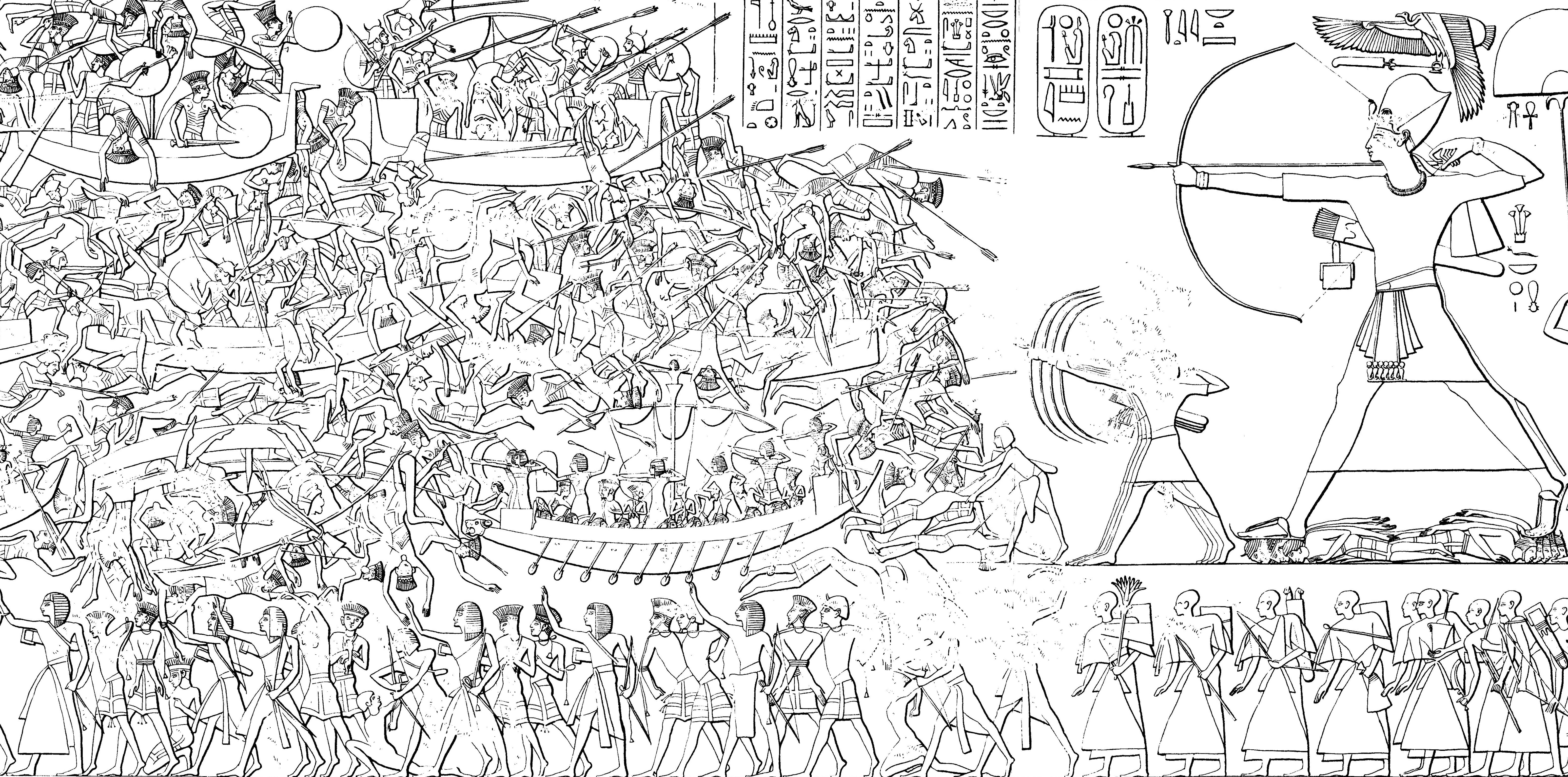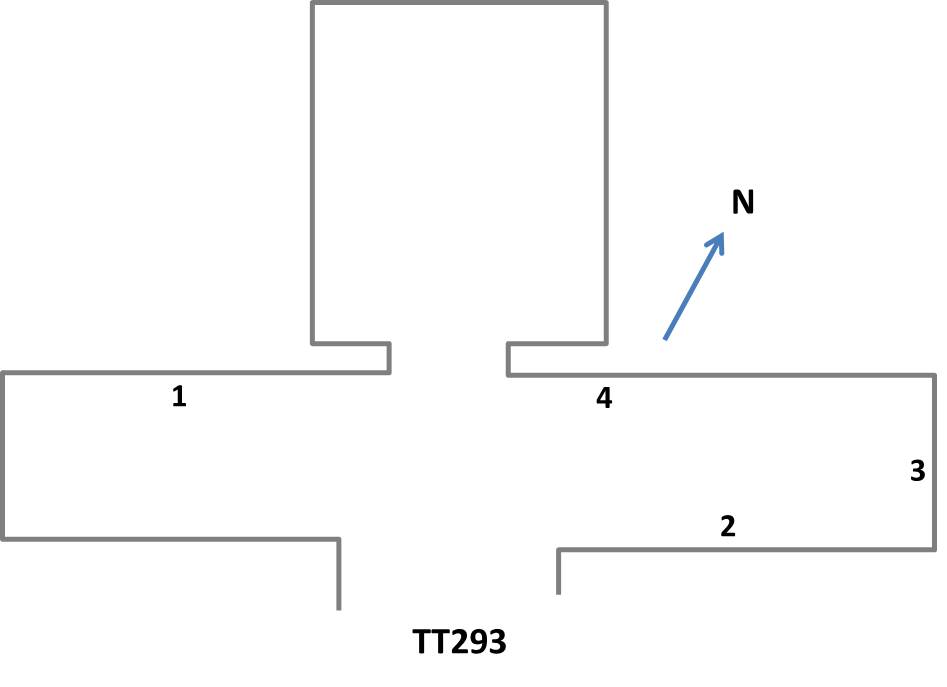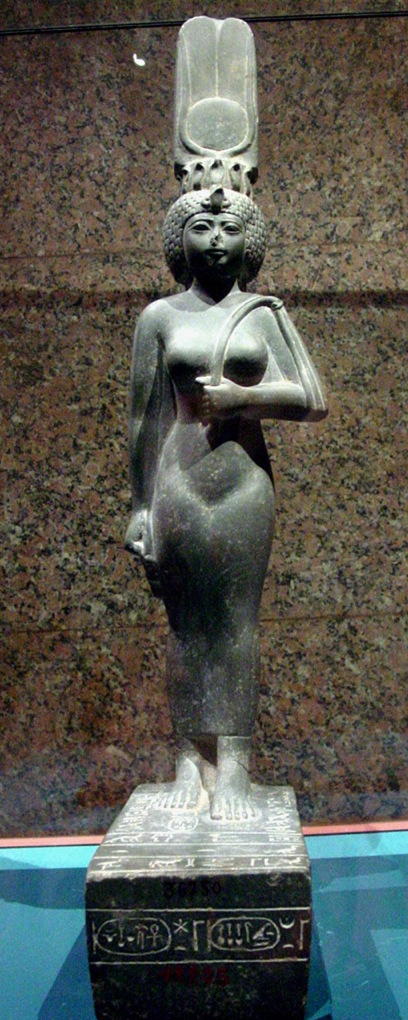|
Ramesses VI
Ramesses VI Nebmaatre-Meryamun (sometimes written Ramses or Rameses, also known under his princely name of Amenherkhepshef C) was the fifth ruler of the Twentieth Dynasty of Egypt. He reigned for about eight years in the mid-to-late 12th century BC and was a son of Ramesses III and queen Iset Ta-Hemdjert. As a prince, he was known as Ramesses Amunherkhepeshef and held the titles of royal scribe and cavalry general. He was succeeded by his son, Ramesses VII, Ramesses VII Itamun, whom he had fathered with queen Nubkhesbed. After the death of the ruling pharaoh, Ramesses V, who was the son of Ramesses VI's older brother, Ramesses IV, Ramesses VI ascended the throne. In the first two years after his Coronation of the pharaoh, coronation, Ramesses VI stopped frequent raids by Libyan or Egyptian marauders in Upper Egypt and buried his predecessor in what is now an unknown tomb of the Theban necropolis. Ramesses VI usurped KV9, a tomb in the Valley of the Kings planned by and for Rames ... [...More Info...] [...Related Items...] OR: [Wikipedia] [Google] [Baidu] |
Twentieth Dynasty Of Egypt
The Twentieth Dynasty of Egypt (notated Dynasty XX, alternatively 20th Dynasty or Dynasty 20) is the third and last dynasty of the Ancient Egyptian New Kingdom period, lasting from 1189 BC to 1077 BC. The 19th and 20th Dynasties together constitute an era known as the Ramesside period owing to the predominance of rulers with the given name "Ramesses". This dynasty is generally considered to mark the beginning of the decline of Ancient Egypt at the transition from the Late Bronze to Iron Age. During the period of the Twentieth Dynasty, Ancient Egypt faced the crisis of invasions by Sea Peoples. The dynasty successfully defended Egypt, while sustaining heavy damage. History After the death of the last pharaoh of the 19th Dynasty, Queen Twosret, Egypt entered into a period of civil war. Because of lost historical records, the cause of the civil war is unknown. The war was ended with the accession to the throne by Setnakhte, who founded the 20th Dynasty of Egypt. From the reign ... [...More Info...] [...Related Items...] OR: [Wikipedia] [Google] [Baidu] |
British Museum
The British Museum is a Museum, public museum dedicated to human history, art and culture located in the Bloomsbury area of London. Its permanent collection of eight million works is the largest in the world. It documents the story of human culture from its beginnings to the present.Among the national museums in London, sculpture and decorative art, decorative and applied art are in the Victoria and Albert Museum; the British Museum houses earlier art, non-Western art, prints and drawings. The National Gallery holds the national collection of Western European art to about 1900, while art of the 20th century on is at Tate Modern. Tate Britain holds British Art from 1500 onwards. Books, manuscripts and many works on paper are in the British Library. There are significant overlaps between the coverage of the various collections. Established in 1753, the British Museum was the first public national museum. In 2023, the museum received 5,820,860 visitors, 42% more than the previous y ... [...More Info...] [...Related Items...] OR: [Wikipedia] [Google] [Baidu] |
Amun-her-khepeshef
Amun-her-khepeshef (died c. 1254 BC; also Amonhirkhopshef, Amun-her-wenemef and Amun-her-khepeshef A) was the firstborn son of Pharaoh Ramesses II and Queen Nefertari. Name He was born when his father was still a co-regent with Seti I. He was originally called ''Amun-her-wenemef'' ("Amun Is with His Right Arm"). He changed his name to ''Amun-her- khepeshef'' ("Amun Is with His Strong Arm") early in his father's reign.Aidan Dodson & Dyan Hilton, ''The Complete Royal Families of Ancient Egypt'', Thames & Hudson (2004), p.170 He appears to have changed his name once again to ''Seth-her-khepeshef'' around Year 20 of Ramesses II. Seth-her-khepeshef was formerly thought to be another son of Ramesses II. Biography Amun-her-khepeshef was first in line to inherit the throne of Egypt from his father, Ramesses II's. He died before inheriting his father's titles 25 years into his father's rule.Dodson & Hilton, p.173 Ramesses B, Ramesses II's second oldes ... [...More Info...] [...Related Items...] OR: [Wikipedia] [Google] [Baidu] |
Lower Egypt
Lower Egypt ( ') is the northernmost region of Egypt, which consists of the fertile Nile Delta between Upper Egypt and the Mediterranean Sea, from El Aiyat, south of modern-day Cairo, and Dahshur. Historically, the Nile River split into seven branches of the delta in Lower Egypt. Lower Egypt was divided into nomes and began to advance as a civilization after 3600 BC. Today, it contains two major channels that flow through the delta of the Nile River – Mahmoudiyah Canal (ancient Agathos Daimon) and Muways Canal (, "waterway of Moses"). Name In Ancient Egyptian, Lower Egypt was known as ''mḥw'' which means "north". Later on, during Antiquity and the Middle Ages, Greeks and Romans called it ''Κάτω Αἴγυπτος'' or ''Aegyptus Inferior'' both meaning "Lower Egypt", but Copts carried on using the old name related to the north – ''Tsakhet'' () or ''Psanemhit'' () meaning the "Northern part". It was further divided into a number of regions or nomes () – '' ... [...More Info...] [...Related Items...] OR: [Wikipedia] [Google] [Baidu] |
Pi-Ramesses
Pi-Ramesses (; Ancient Egyptian: , meaning "House of Ramesses") was the new capital built by the Nineteenth Dynasty of Egypt, Nineteenth Dynasty Pharaoh Ramesses II (1279–1213 BC) at Qantir, near the old site of Avaris. The city had served as a summer palace under Seti I (c. 1290–1279 BC), and may have been founded by Ramesses I (c. 1292–1290 BC) while he served under Horemheb. Discovery In 1884, Flinders Petrie arrived in Egypt to begin his excavations there. His first dig was at Tanis, Egypt, Tanis, where he arrived with 170 workmen. Later in the 1930s, the ruins at Tanis were explored by Pierre Montet. The masses of broken Ramesside stonework at Tanis led archaeologists to identify it as Pi-Ramesses. Yet it eventually came to be recognised that none of these monuments and inscriptions originated at the site. In the 1960s, Manfred Bietak recognised that Pi-Ramesses was known to have been located on the then-easternmost branch of the Nile. He painstakingly mapped all the ... [...More Info...] [...Related Items...] OR: [Wikipedia] [Google] [Baidu] |
Ramessesnakht
Ramessesnakht was High Priest of Amun during many years in the 20th Dynasty. He was appointed as the High Priest at Thebes under Ramesses IV. He served in office until the reign of Ramesses IX. It was during Ramessesnakht's tenure that the power and importance of the Amun priesthood grew over Egypt while the Pharaoh's power began to noticeably decline. Biography He was the son of Meribastet, steward to the pharaoh. Ramessesnakht was married to Adjedet-Aat, the daughter of Setau, High Priest of Nekhbet, and had at least two sons: Amenhotep and Nesamun and a daughter Tamerit. His son Amenhotep would succeed him in office and there is evidence that, at least for a while, his son, the Second Prophet of Amun Nesamun also acted as High Priest of Amun. His daughter Tamerit married Amenemopet, Third Prophet of Amun, making the family related through marriage to another important priestly family, that of Bakenkhonsu who served as High Priest of Amun under Ramesses II. (Amenemopet w ... [...More Info...] [...Related Items...] OR: [Wikipedia] [Google] [Baidu] |
High Priests Of Amun
The High Priest of Amun or First Prophet of Amun ('' ḥm nṯr tpj n jmn'') was the highest-ranking priest in the priesthood of the ancient Egyptian god Amun. The first high priests of Amun appear in the New Kingdom of Egypt, at the beginning of the Eighteenth Dynasty. History The priesthood of Amun rose in power during the early Eighteenth dynasty through significant tributes to the god Amun by rulers such as Hatshepsut and more importantly Thutmose III. The Amun priesthood in Thebes had four high-ranking priests: * The Chief Prophet of Amun at Karnak (''ḥm nṯr tpj n jmn''), also referred to as the Chief Priest of Amun. * The Second Prophet of Amun at Karnak (''ḥm nṯr snnw n jmn''), also referred to as the Second Priest of Amun. * The Third Prophet of Amun at Karnak (''ḥm nṯr ḫmtnw n jmn khemet-nu''), also referred to as the Third Priest of Amun. * The Fourth Prophet of Amun at Karnak (''ḥm nṯr jfdw n jmn''), also referred to as the Fourth Priest of Amun. ... [...More Info...] [...Related Items...] OR: [Wikipedia] [Google] [Baidu] |
God's Wife Of Amun
God's Wife of Amun ( Egyptian: ''ḥm.t nṯr n ỉmn'') was the highest-ranking priestess of the Amun cult, an important religious institution in ancient Egypt. The cult was centered in Thebes in Upper Egypt during the Twenty-fifth and Twenty-sixth dynasties (circa 740–525 BC). The office had political importance as well as religious, since the two were closely related in ancient Egypt. Although the title is first attested in the Middle Kingdom, its full political potential was not realized until the advent of the Eighteenth Dynasty. History of the office nTr-N41:X1 The shorter version of the title, God's Wife, is in use by the time of the Twelfth Dynasty, when the title is attested for the non-royal women Iy-meret-nebes and Neferu.Mariam F. Ayad (2009), ''God’s Wife, God’s Servant''. As early as the First Intermediate Period, there is mention of a "Wife of the God" in reference to the god Min. The full title of God's Wife of Amun is only used during and after ... [...More Info...] [...Related Items...] OR: [Wikipedia] [Google] [Baidu] |
Nubia
Nubia (, Nobiin language, Nobiin: , ) is a region along the Nile river encompassing the area between the confluence of the Blue Nile, Blue and White Nile, White Niles (in Khartoum in central Sudan), and the Cataracts of the Nile, first cataract of the Nile (south of Aswan in southern Egypt) or more strictly, Al Dabbah, Sudan, Al Dabbah. It was the seat of one of the earliest civilizations of ancient Africa, the Kerma culture, which lasted from around 2500 BC until its conquest by the New Kingdom of Egypt under Pharaoh Thutmose I around 1500 BC, whose heirs ruled most of Nubia for the next 400 years. Nubia was home to several African empires, empires, most prominently the Kingdom of Kush, which conquered Egypt in the eighth century BC during the reign of Piye and ruled the country as its Twenty-fifth Dynasty of Egypt, 25th Dynasty. From the 3rd century BC to 3rd century AD, northern Nubia was invaded and annexed to Egypt, ruled by the Ptolemaic Kingdom, Greeks and Roman Empire, R ... [...More Info...] [...Related Items...] OR: [Wikipedia] [Google] [Baidu] |
Canaan
CanaanThe current scholarly edition of the Septuagint, Greek Old Testament spells the word without any accents, cf. Septuaginta : id est Vetus Testamentum graece iuxta LXX interprets. 2. ed. / recogn. et emendavit Robert Hanhart. Stuttgart : Dt. Bibelges., 2006 . However, in modern Greek, the accentuation is , while the Novum Testamentum Graece, current (28th) scholarly edition of the New Testament has . was an Ancient Semitic-speaking peoples, ancient Semitic-speaking civilization and region of the Southern Levant during the late 2nd millennium BC. Canaan had significant geopolitical importance in the Late Bronze Age Amarna Period (14th century BC) as the area where the sphere of influence, spheres of interest of the Egyptian Empire, Egyptian, Hittites, Hittite, Mitanni, and Assyrian Empires converged or overlapped. Much of present-day knowledge about Canaan stems from Excavation (archaeology), archaeological excavation in this area at sites such as Tel Hazor, Tel Megiddo, ... [...More Info...] [...Related Items...] OR: [Wikipedia] [Google] [Baidu] |
Valley Of The Queens
The Valley of the Queens is a site in Egypt, in which queens, princes, princesses, and other high-ranking officials were buried from roughly 1560 BC to 1130 BC. Pharaohs were buried in the Valley of the Kings. The Valley of the Queens was known anciently as ''Ta-Set-Neferu'', which has a double meaning of "The Place of Beauty" and/or "the Place of the Royal Children". Excavation of the tombs at the Valley of the Queens was pioneered by Ernesto Schiaparelli and Francesco Ballerini in the early 1900s. The Valley of the Queens consists of the main wadi, which contains most of the tombs, along with the Valley of Prince Ahmose, the Valley of the Rope, the Valley of the Three Pits, and the Valley of the Dolmen. The main wadi contains 91 tombs and the subsidiary valleys add another 19 tombs. The burials in the subsidiary valleys all date to the Eighteenth dynasty of Egypt, 18th Dynasty.Demas, Martha, and Neville Agnew, eds. 2012. Valley of the Queens Assessment Report: Volume 1. Los Angel ... [...More Info...] [...Related Items...] OR: [Wikipedia] [Google] [Baidu] |
KV62
The tomb of Tutankhamun (reigned ), a pharaoh of the Eighteenth Dynasty of ancient Egypt, is located in the Valley of the Kings. The tomb, also known by its tomb number KV62, consists of four chambers and an entrance staircase and corridor. It is smaller and less extensively decorated than other Egyptian royal tombs of its time, and it probably originated as a tomb for a non-royal individual that was adapted for Tutankhamun's use after his premature death. Like other pharaohs, Tutankhamun was buried with a wide variety of funerary objects and personal possessions, such as coffins, furniture, clothing and jewelry, though in the unusually limited space these goods had to be densely packed. Robbers entered the tomb twice in the years immediately following the burial, but Tutankhamun's mummy and most of the burial goods remained intact. The tomb's low position, dug into the floor of the valley, allowed its entrance to be hidden by debris deposited by flooding and tomb construction. ... [...More Info...] [...Related Items...] OR: [Wikipedia] [Google] [Baidu] |











